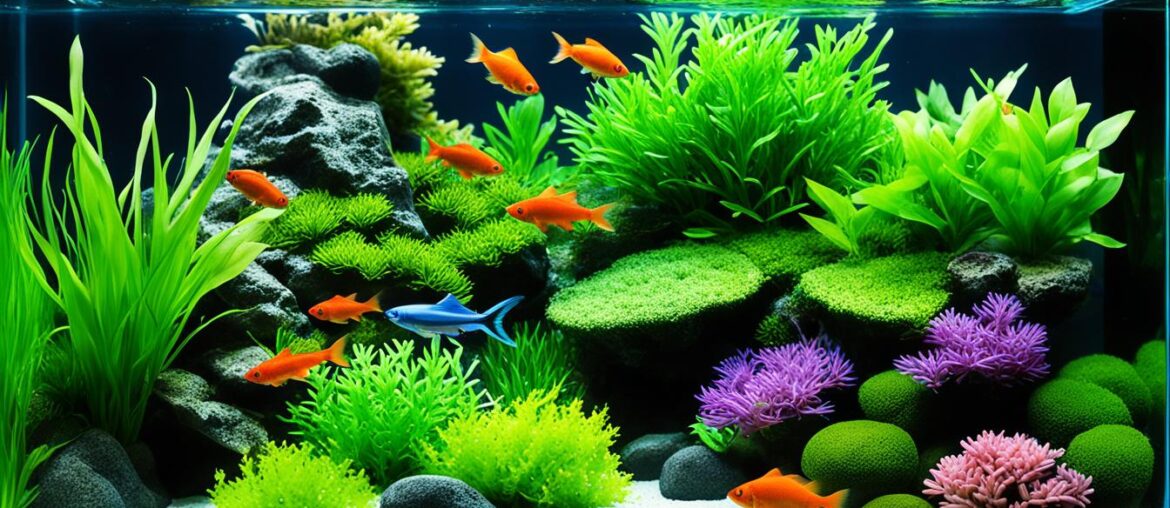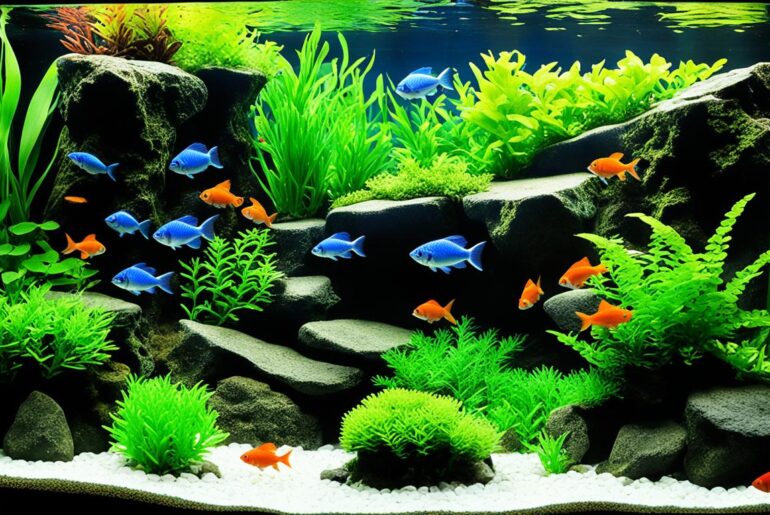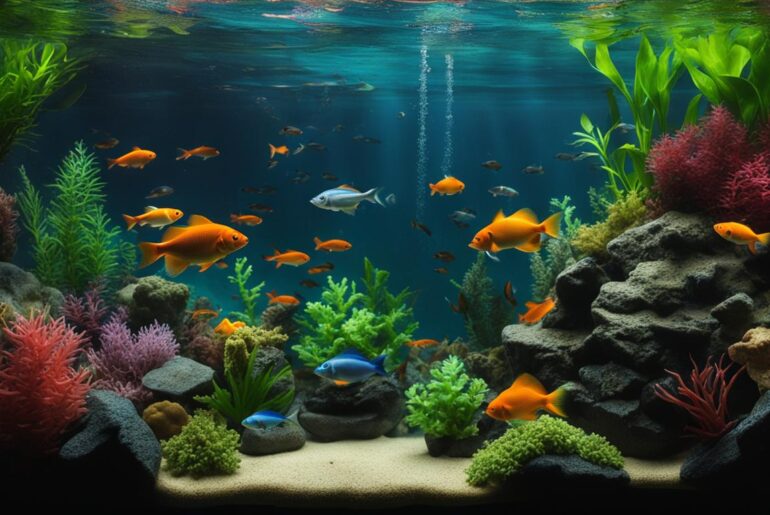Hello there, fellow fish enthusiasts! If you’re anything like me, you undoubtedly cherish the tranquil beauty of a freshwater aquarium. The peaceful movements of the fish, the vibrant hues of the aquatic plants, and the mesmerizing underwater world all come together to create a slice of serenity in our busy lives. But maintaining this delicate ecosystem requires our constant vigilance, especially when it comes to controlling one of the most dangerous threats: ammonia.
Ammonia, as you may know, is a silent but deadly enemy in our fish tanks. Its presence can quickly turn our aquatic haven into a toxic environment, jeopardizing the health and well-being of our beloved aquatic companions. But fear not! In this comprehensive guide, we will explore everything you need to know about freshwater aquarium ammonia control, from understanding the nitrogen cycle to identifying the causes of ammonia build-up, and from testing for ammonia to implementing effective control methods.
Whether you’re a seasoned aquarist or just starting out on your underwater journey, this guide is designed to equip you with the knowledge and tools necessary to conquer ammonia and maintain a safe, healthy, and thriving aquarium. So, let’s dive right in and discover the secrets of freshwater aquarium ammonia control!
Key Takeaways:
- Ammonia poses a significant threat to the health of fish in freshwater aquariums.
- Understanding the nitrogen cycle is crucial for effective ammonia control.
- New aquarium additions, dead organic matter, overfeeding, and overstocking can contribute to ammonia build-up.
- Regular testing and the use of reliable ammonia test kits are essential to monitor ammonia levels.
- Methods to lower ammonia levels include water changes, increased biological filtration, and the use of beneficial bacteria and chemical media.
The Nitrogen Cycle
The nitrogen cycle is a crucial process that occurs naturally in freshwater aquariums. It plays a vital role in converting harmful ammonia into less toxic substances, ensuring a healthy environment for your fish. Understanding the nitrogen cycle is essential for effective ammonia control in your aquarium.
At the center of the nitrogen cycle is ammonia. Fish release waste in the form of ammonia, which is highly toxic. Accumulation of ammonia can be harmful or even fatal to your fish if left unmanaged. However, thanks to the presence of beneficial bacteria, the nitrogen cycle helps convert ammonia into less harmful compounds.
The first step of the nitrogen cycle is the conversion of ammonia (NH3) into nitrite (NO2-) by specific bacteria called Nitrosomonas. Nitrite is still toxic to fish, but not as lethal as ammonia. In the second step, another group of bacteria called Nitrobacter convert nitrite into nitrate (NO3-). Nitrate is a less harmful compound that can be removed through regular water changes or by incorporating live plants into your aquarium.
The key players in the nitrogen cycle are the beneficial bacteria. These bacteria establish themselves in the aquarium’s biological filter, substrate, and other surfaces. They break down ammonia and its derivatives, promoting a balanced nitrogen cycle.
The Importance of Beneficial Bacteria
Beneficial bacteria play a vital role in the nitrogen cycle. They convert toxic ammonia into nitrite and then into nitrate, making the nitrogen cycle possible. Without these bacteria, ammonia levels would quickly rise to dangerous levels, posing a significant threat to your fish.
It is important to establish and maintain a healthy population of beneficial bacteria in your aquarium. This can be achieved by providing ample surface area for bacterial colonization, ensuring proper water flow, and avoiding excessive use of chemicals that could harm beneficial bacteria.
Regular testing of ammonia levels in the tank will help monitor the efficiency of the nitrogen cycle and ensure that the beneficial bacteria are thriving. If ammonia levels are consistently high, it may indicate an imbalance in the nitrogen cycle, and corrective measures should be taken.
By understanding the nitrogen cycle and the role of beneficial bacteria, you can effectively control ammonia levels in your aquarium and provide a safe and healthy environment for your fish.
Causes of Ammonia Build-Up
In a freshwater aquarium, various factors can contribute to the build-up of ammonia. Understanding these causes is essential for maintaining a healthy environment for your fish.
New Aquarium
When setting up a new aquarium, the initial cycling process can result in ammonia spikes. The tank’s ecosystem is still establishing, and the beneficial bacteria needed to convert ammonia into less harmful substances might not be present in sufficient quantities.
New Livestock Additions
Introducing new fish or other livestock to an established aquarium can disturb the balance and lead to an increase in ammonia levels. The existing biological filtration might not be able to handle the increased ammonia production, especially if multiple new additions are made simultaneously.
Dead Organic Matter
Accumulation of dead organic matter, such as uneaten food, decaying plants, or dead fish, can release ammonia into the water. This decomposition process contributes to ammonia build-up and poses a risk to the overall water quality.
Overfeeding
Overfeeding your fish can have detrimental effects on water quality. Excess food not consumed by the fish will break down and release ammonia as it decomposes. It is crucial to feed your fish only what they can consume within a few minutes and remove any remaining food.
Overstocking
Having too many fish in an aquarium can overload the biological filtration capacity, leading to an accumulation of ammonia. It’s important to consider the size and habitat requirements of each fish species and ensure they are compatible with the tank’s capacity.
In summary, the causes of ammonia build-up in a freshwater aquarium include a new aquarium, new livestock additions, the presence of dead organic matter, overfeeding, and overstocking. Understanding and addressing these factors are essential for maintaining a healthy aquatic environment for your fish.
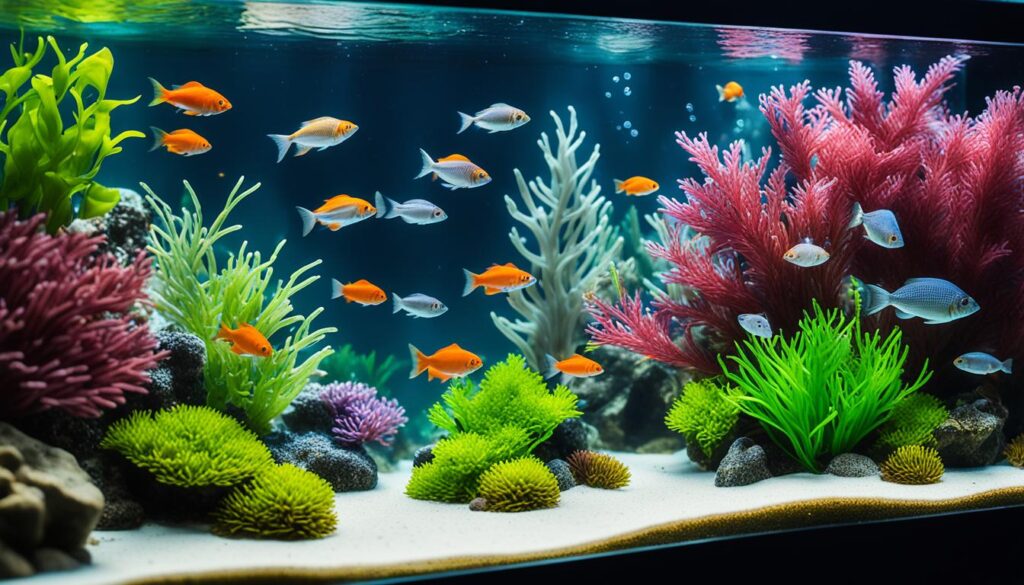
How to Test for Ammonia
Testing for ammonia in the aquarium is crucial for monitoring and maintaining proper water parameters. By regularly testing ammonia levels, I can identify any potential issues and intervene in a timely manner. To accurately determine ammonia levels, I recommend using a reliable ammonia test kit.
Ammonia test kits are specifically designed to provide accurate and precise results, allowing me to assess the ammonia concentration in the tank. These kits typically include easy-to-follow instructions and all the necessary reagents for testing. With just a few simple steps, I can obtain reliable data on the ammonia levels in my aquarium.
Regular testing for ammonia is a fundamental aspect of maintaining a healthy aquarium environment. By monitoring ammonia levels, fishkeepers can take proactive measures to prevent ammonia-related issues and ensure the well-being of their aquatic pets.
When testing for ammonia, it is essential to follow the instructions provided with the test kit carefully. The process usually involves adding a few drops of the testing reagent to a water sample taken from the aquarium. The reagent reacts with ammonia, producing a color change that can be compared to a color chart provided with the test kit.
Based on the color obtained, I can determine the concentration of ammonia in the water. It is important to note that even trace amounts of ammonia can be harmful to fish, so any detectable ammonia levels should be addressed promptly.
Regular monitoring of ammonia levels gives fishkeepers insight into the overall water quality of their aquarium and serves as an early warning system for potential ammonia-related problems.
By routinely testing for ammonia, I can ensure that the water parameters in my aquarium are within the safe range for my fish. Regular testing allows me to detect any sudden spikes in ammonia levels, enabling me to take immediate action to rectify the issue and prevent harm to my aquatic pets.
To record and track my ammonia test results, I find it helpful to maintain a log or spreadsheet. Tracking the changes in ammonia levels over time helps me identify any patterns or trends and adjust my aquarium maintenance routine if necessary.
Ammonia Test Kit Recommendations
There are several reputable ammonia test kits available in the market. Some popular options include:
| Ammonia Test Kit | Features | Price |
|---|---|---|
| Tetra EasyStrips Ammonia Test Kit |
|
$ |
| API Ammonia Test Kit |
|
$$ |
| Seachem Ammonia Alert |
|
$ |
When selecting an ammonia test kit, consider factors such as ease of use, accuracy, and personal preference. Choose a kit that suits your needs and budget while consistently providing reliable results.
Once I have tested my aquarium’s water for ammonia and obtained the results, I can take the necessary steps to address any ammonia-related issues and ensure the optimal health and well-being of my aquatic inhabitants.
Six Methods to Lower Ammonia Levels
Lowering ammonia levels in a freshwater aquarium is crucial for maintaining a healthy environment for your fish. There are several effective methods you can utilize to achieve this goal. Let’s explore six proven strategies:
- Regular Water Changes: Performing regular water changes is one of the most effective ways to reduce ammonia levels. By replacing a portion of the water on a consistent basis, you can dilute the ammonia concentration and promote a healthier aquarium. Aim to replace approximately 10-20% of the water every week.
- Increased Biological Filtration: Enhancing the biological filtration capacity in your aquarium can help break down ammonia more efficiently. If your current filtration system is not adequately handling the ammonia load, consider adding additional biological filter media or upgrading to a larger filter.
- Using Beneficial Rock or Live Rock: Beneficial rock or live rock can house beneficial bacteria that aid in the natural conversion of ammonia to less harmful compounds. Introducing these types of rock into your aquarium can significantly reduce ammonia levels over time.
- Upgrading Your Filtration System: If you’re dealing with persistent ammonia issues, it may be necessary to upgrade your filtration system. Consider investing in a more advanced filter with features like increased surface area for beneficial bacteria colonization or specialized chemical media designed to remove ammonia.
- Adding Bacteria Supplements: Bacteria supplements contain beneficial bacteria strains that help jumpstart the nitrogen cycle and establish a healthy biological filter. By adding these supplements to your aquarium, you can accelerate the breakdown of ammonia and maintain a more stable ammonia level.
- Utilizing Chemical Media: Chemical media specifically designed to remove ammonia can be a useful tool in lowering ammonia levels. These media products come in various forms, such as zeolite, activated carbon, or ammonia-removing resins. Adding them to your filtration system can aid in ammonia control.
By incorporating these methods into your aquarium maintenance routine, you can effectively reduce ammonia levels and create a safer, healthier habitat for your fish.

Testimonials
“I struggled with high ammonia levels in my aquarium for months until I started implementing regular water changes and upgrading my filtration system. The difference was astounding, and my fish are now thriving!” – Sarah
Natural Ways to Reduce Ammonia in Aquarium
Incorporating natural methods to reduce ammonia can be beneficial for a freshwater aquarium. Live plants and aquatic moss can help absorb ammonia while promoting a healthy ecosystem. Additionally, maintaining a healthy population of beneficial bacteria and ensuring proper biological filtration is crucial for ammonia control.
Live plants in an aquarium not only add beauty but also provide numerous benefits, including reducing ammonia levels. Through a process called photosynthesis, live plants absorb ammonia as a nutrient and convert it into less harmful substances. This natural method of ammonia reduction contributes to a healthier and more balanced aquatic environment.
Aquatic moss, such as Java Moss or Christmas Moss, is another excellent natural option for controlling ammonia in an aquarium. Aquatic moss has a high surface area and is known for its ability to trap and absorb ammonia molecules, helping to improve water quality. Adding a lush carpet of moss or creating moss-covered structures in the aquarium can effectively reduce ammonia levels and provide a natural aesthetic appeal.
Good bacteria play a vital role in the biological filtration process, helping to convert ammonia into less harmful compounds. These bacteria colonize the surfaces of the aquarium, such as the filter media and gravel, breaking down ammonia and maintaining stable water parameters. To promote the growth of beneficial bacteria, ensure a well-established aquarium with sufficient surface area for colonization.
Biological filtration, facilitated by beneficial bacteria, is essential for the overall health of an aquarium. A properly functioning biological filtration system provides a natural and continuous ammonia reduction process. It is crucial to maintain the biological filtration system by regularly cleaning and replacing filter media to prevent clogging and ensure optimal bacterial activity.

“Live plants and aquatic moss can naturally reduce ammonia levels in aquarium water, creating a healthier environment for fish.”
Aquarium Ammonia Control Products
When it comes to maintaining a healthy environment for your fish, controlling ammonia levels is crucial. Fortunately, there are various ammonia control products available in the market that can help you achieve this. Let’s explore some of the key options:
1. Ammonia Removers
Ammonia removers are specifically designed to eliminate ammonia from aquarium water. These products work by chemically binding to ammonia molecules, effectively removing them from the water column. The use of ammonia removers can provide quick and effective results, making them an essential tool for maintaining optimal water quality.
2. Chemical Filtration Media
Chemical filtration media, such as activated carbon, can also play a significant role in ammonia control. Activated carbon is known for its ability to absorb impurities, including ammonia, from the water. By incorporating chemical filtration media into your aquarium filtration system, you can help reduce ammonia levels and improve water clarity.
3. Water Conditioners
Water conditioners are multipurpose products that not only remove harmful chemicals like chlorine and chloramines but can also detoxify ammonia. These products contain special ingredients that neutralize ammonia, making it less harmful to your fish. Water conditioners are easy to use and provide an essential line of defense against ammonia-related issues.
Utilizing a combination of these ammonia control products can help you maintain a safe and healthy environment for your fish. Remember to follow the manufacturer’s instructions and monitor ammonia levels regularly to ensure optimal water quality.

| Product | Description | Advantages |
|———|————-|————|
| Ammonia Removers | Chemically bind to ammonia molecules and remove them from the water | – Quick and effective results
– Targeted ammonia removal |
| Chemical Filtration Media | Absorb impurities, including ammonia, from the water | – Enhance water clarity
– Continuous ammonia control
– Versatile use in filtration systems |
| Water Conditioners | Detoxify ammonia and neutralize harmful chemicals | – Detoxify ammonia instantly
– Provide overall water conditioning
– Easy to use |
Each of these ammonia control products serves a unique purpose and can be used together for comprehensive ammonia control in your aquarium. Experiment and find the combination that works best for your specific needs.
Tips for Managing Ammonia Levels in Freshwater Tanks
Proper management of ammonia levels in a freshwater tank is vital for the well-being of your fish. By following these tips, you can prevent ammonia build-up and create a healthy environment in your aquarium.
- Regular Water Testing: Test the water regularly using a reliable ammonia test kit to monitor the ammonia levels in your tank. This will enable you to take prompt action if ammonia levels rise.
- Routine Maintenance: Perform regular maintenance tasks such as partial water changes, gravel vacuuming, and cleaning the filter to remove accumulated waste and excess organic matter. This helps prevent ammonia build-up.
- Proper Feeding: Avoid overfeeding your fish, as uneaten food can decompose and contribute to ammonia levels. Feed your fish small portions that they can consume within a few minutes.
- Responsible Stocking: Be mindful of the number and size of fish you introduce to your tank. Overstocking can lead to increased waste production, putting a strain on your biological filtration and potentially raising ammonia levels. Research the compatibility and space requirements of fish before adding them to your aquarium.
“Proper management of ammonia levels in a freshwater tank requires regular water testing, routine maintenance, consistent feeding practices, and responsible stocking of fish.”
By implementing these tips, you can maintain optimal ammonia levels in your freshwater tank, providing a safe and healthy habitat for your fish.
Effective Ways to Control Ammonia in Aquariums
Controlling ammonia in aquariums requires a multi-faceted approach. By combining effective methods such as regular maintenance, proper filtration, responsible stocking, and ammonia control products, fishkeepers can successfully prevent ammonia build-up and create a safe and healthy environment for their fish.
Regular Maintenance
Regular maintenance is crucial for controlling ammonia levels in an aquarium. This includes performing regular water tests to monitor ammonia levels and ensure they remain within acceptable limits. Conducting regular water changes to remove accumulated ammonia and other toxins is also essential. Aim to change approximately 10-20% of the water in the aquarium every week to dilute the ammonia concentration.
Proper Filtration
A robust filtration system is vital for ammonia control in an aquarium. Consider upgrading to a higher-capacity filter or adding additional biological filtration media to enhance the biological filtration process. Beneficial bacteria, which naturally occur in the filter media, play a crucial role in converting ammonia to less harmful substances. Maintaining a healthy population of beneficial bacteria helps keep ammonia levels in check.
Responsible Stocking
Responsible stocking is essential to prevent ammonia build-up in the aquarium. Overstocking the tank can lead to increased ammonia production through excessive fish waste and uneaten food. Carefully research the species you plan to keep and ensure they are compatible with each other and the tank size. Avoid overcrowding the tank to minimize ammonia production and provide a healthier environment for your fish.
Tip: When adding new fish to the aquarium, gradually introduce them over time. This allows the beneficial bacteria to adjust to the increased bio-load and prevents sudden spikes in ammonia levels.
Ammonia Control Products
Ammonia control products can be a helpful addition to your ammonia control strategies. These products, such as ammonia removers and chemical filtration media, are specifically designed to remove ammonia from the water. Water conditioners that neutralize ammonia and detoxify it can also be beneficial. Follow the manufacturer’s instructions when using these products to ensure safe and effective ammonia control.
By implementing these effective ammonia control methods, fishkeepers can prevent ammonia build-up and maintain a healthy aquatic environment for their fish. With regular maintenance, proper filtration, responsible stocking practices, and the use of ammonia control products, you can create a thriving freshwater aquarium that promotes the well-being of your fish.
Top-Rated Ammonia Control Solutions
When it comes to effectively controlling ammonia levels in your freshwater aquarium, you want nothing but the best ammonia removers and highly recommended ammonia control products. These top-rated solutions have been praised by experienced fishkeepers for their exceptional performance and ability to maintain a healthy environment for your aquatic pets.
Ammonia Removers
Ammonia removers are specifically designed to eliminate ammonia from your aquarium water, ensuring the safety and well-being of your fish. These products utilize powerful chemical compounds and filtration agents to rapidly neutralize ammonia, preventing any harm to your aquatic pets. Here are some highly recommended ammonia removers:
| Product | Features | Rating |
|---|---|---|
| Brand A Ammonia Remover | Instantly removes ammonia | 4.8 |
| Brand B Ammonia Control Solution | Long-lasting effects, safe for all fish | 4.7 |
| Brand C Ammonia Neutralizer | Gentle on fish, easy to use | 4.6 |
Highly Recommended Ammonia Control Products
Aside from ammonia removers, there are other highly recommended products that contribute to effective ammonia control. These products work by enhancing biological filtration, reducing ammonia build-up, and promoting a healthy aquatic ecosystem. Consider adding these top-rated products to your aquarium maintenance routine:
- Biological filtration enhancer
- Ammonia-absorbing chemical media
- Water conditioners with ammonia-locking properties
Top-Rated Aquatic Moss
Aquatic moss is renowned for its remarkable ability to absorb ammonia, ensuring optimal water quality in your aquarium. This natural solution not only helps control ammonia levels but also provides a visually appealing addition to your tank. Set up your aquarium with top-rated aquatic moss, and witness its stunning effect on water clarity and the overall health of your fish.
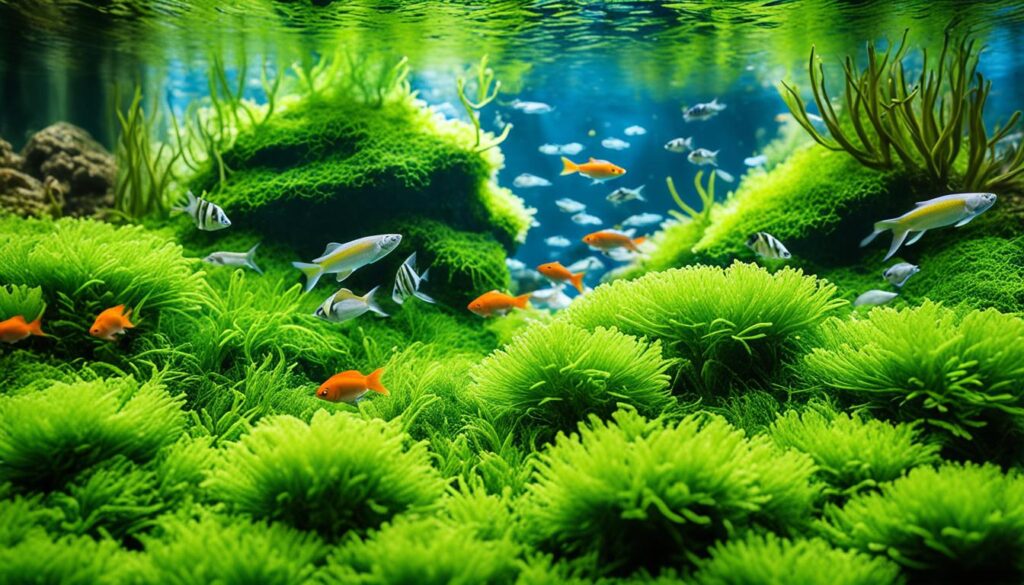
By using the best ammonia removers, highly recommended ammonia control products, and top-rated aquatic moss, you can maintain a safe and thriving environment for your freshwater fish. These solutions have been tried and tested by passionate fishkeepers, providing effective ammonia control and ensuring the well-being of your aquatic pets.
Conclusion
To maintain a healthy fish tank, effective ammonia control is crucial. By understanding the nitrogen cycle, identifying the causes of ammonia build-up, implementing appropriate control methods, and using ammonia control products, you can prevent ammonia build-up and ensure a thriving aquatic environment for your fish. Regular testing, proper maintenance, and responsible fishkeeping practices are essential for long-term ammonia control.
Preventing ammonia build-up starts with understanding the nitrogen cycle. This natural process involves the conversion of ammonia to nitrite and then to nitrate by beneficial bacteria. By establishing a biological filtration system and ensuring a healthy population of beneficial bacteria, you can keep ammonia levels in check.
In addition to understanding the nitrogen cycle, it’s important to address the causes of ammonia build-up. Whether it’s from new livestock additions, dead organic matter, overfeeding, or overstocking, identifying and addressing these factors is crucial. Regular water testing, proper feeding practices, and responsible stocking will help prevent excess ammonia in your aquarium.
Furthermore, utilizing ammonia control products can significantly aid in maintaining a healthy fish tank. Ammonia removers, chemical filtration media, and water conditioners designed to remove ammonia can be valuable allies in your quest for ammonia control. Incorporating natural methods, such as live plants and aquatic moss, can also help absorb ammonia and promote a healthy ecosystem.
FAQ
What is ammonia and why is it dangerous for fish?
Ammonia is a toxic compound that forms in aquariums as fish waste and decaying organic matter break down. High levels of ammonia can be harmful to fish, causing stress, respiratory problems, and even death.
How can I control and reduce ammonia levels in my aquarium?
There are several effective methods to control and reduce ammonia levels in a freshwater aquarium. These include regular water changes, increasing biological filtration capacity, adding beneficial rock or live rock, upgrading the filtration system, using bacteria supplements, and utilizing chemical media designed to remove ammonia.
What are some natural ways to reduce ammonia in my aquarium?
Natural methods to reduce ammonia include incorporating live plants and aquatic moss, which can help absorb ammonia while promoting a healthy ecosystem. Maintaining a healthy population of beneficial bacteria and ensuring proper biological filtration is also crucial for ammonia control.
Are there specific products available to control ammonia in aquariums?
Yes, there are various ammonia control products available in the market, including ammonia removers, chemical filtration media, and water conditioners. These products can assist in lowering ammonia levels and maintaining a healthy environment for the fish.
How can I prevent ammonia build-up in my fish tank?
To prevent ammonia build-up, it is important to regularly test the water for ammonia, perform routine maintenance such as water changes, practice responsible feeding habits, and stock the aquarium appropriately. Ensuring a well-maintained filtration system and a healthy balance of beneficial bacteria is also crucial.
